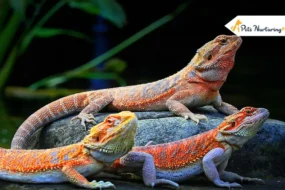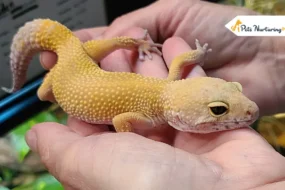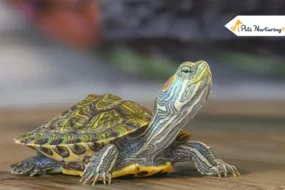
Chameleons are one of the popular reptiles kept as pets and for a reptile enthusiast, there aren’t many things that’ll match the cuteness of a baby chameleon. These cuties are fragile little creatures that have very specific requirements to stay healthy and happy. If your heart has been captured by a chameleon but you’re not entirely sure about how to care for them, we are here to help you!
Let’s begin with a very basic ‘what is a chameleon’ to get to know them better.
Chameleons belong to the class of reptiles. They are highly specialised lizards that are found in a wide range of colours and many even have the ability to change their colour.
Chameleons have horns or crests on their brow and snout, and they have a swaying gait. Chameleons have independently mobile eyes and are adapted for visual hunting. They are amazing climbers and often found in warm climatic zones that may include forests to deserts.
Chameleons are oviparous animals so the baby chameleons hatch out of eggs. Like many oviparous animals and birds, female chameleons lay unfertilised eggs. Which one must be aware of if they want a baby chameleon, as that would mean you need chameleons of both genders to have baby chameleons.
Females can lay 20 to 40 eggs per hatch and the incubation period lasts somewhere between four and nine months depending on the species.
What Does a Baby Chameleon Look Like

A chameleon baby is adorably small, about an inch from head to tail when they are out of the egg. Baby chameleons do change colours but not as much as adult chameleons. They show a slight change in their shade instead of changing their entire colour.
They start walking around right after they hatch out of their egg. That’s their prey instinct, as in the wild there are predators everywhere so they have to be quick in finding a safe shelter.
Chameleons do not show any maternal behaviour, the baby chameleon is on its own from the moment of birth. So these little ones are independent right from the moment they come into the world.
Baby Panther chameleons are the ones commonly found in tropical regions. They grow up to 20 inches in length whereas the males are usually larger. Male panther chameleons show more vibrant colours than females.
Baby panther chameleons show a unique pattern of toes. On each of their feet, their toes are fused in groups of twos and threes, the total number of toes being five. This gives their feet a tong-like appearance. This type of toe arrangement gives them an advantage in climbing as it enables them to grip tighter on the branches of the trees.
In addition to this, they have claws on each toe that are sharp. Chameleons have very unique eyes, their eyelids are joined together, allowing only a slit wide enough for their pupil to see through. They can move their eyes independently, focusing on different objects with each eye.
When they focus their eye on one subject, it can give them depth perception and stereoscopic vision. UV light is a part of their visible spectrum and they can even locate small insects easily from a distance.
The tongue of chameleons is very long, sometimes even longer than the length of their entire body, which is why they can extend them out so fast to catch their prey. Their tongue has a complex design consisting of bone, muscle and sinew. The bone at the base of their tongue is shot forward and gives it the initial momentum to hit the prey at a distance. The tip of the tongue has a club-like, mucous covered structure that works like a suction cup by sticking to the prey.
How Long Do Chameleons Live?

A chameleon’s life span ranges between 2 to 20 years depending on the breed but a baby panther chameleon lives up to 7 years. So if you’re getting one, make sure you are aware of your chameleon’s lifespan, as that is how long you have to commit to their care and nourishment.
The Mystery Behind Their Changing Colour!
Let’s begin with bursting a myth! Most people believe that chameleons change colour depending on which background they are in, that’s FALSE.
Chameleons with desserts as their natural habitat are usually brown, whereas the forest dwellers are green. Depending on their breed, they have a range of colours they can exhibit. These colours are exhibited depending on temperature, mood, threat or other such factors.
Chameleons usually change colour to warm up or cool themselves down. They turn darker in cool weather, as darker colours absorb more heat. They also switch shades to communicate their emotions to their mates or enemies. Chameleons take on brighter colours to attract mates.
How Do They Do It?

Pigments impart colours to plants, animals or any other living being and it’s the same for the chameleons. The outer skin of a chameleon is see-through and beneath it are the layers of specialised cells that contain pigments.
Whenever they experience a shift in their emotion, their brain signals a response and these cells are stimulated to release colours. Colours from different cells mix to give the desired shade.
Chameleon Price
How much does a chameleon costs or a chameleon’s price is one of the curious questions we commonly get.
How much is a chameleon for, depends widely on its species. I’ll mention the prices of the most widely demanded varieties of a chameleon to give you an idea. Baby panther chameleons’ price ranges between 150$ to 200$ due to their collation and how easy they are to care for.
Baby veiled chameleons and baby Jackson chameleons are other commonly preferred chameleons whose price ranges from 20$ to 80$. How much is a chameleon for, also depends on the type of breeder, locality, the reputation of a breeder and many such factors?
How to Take Care of a Chameleon?

1. Housing
Chameleons can be kept in tanks or cages but you need to maintain the right temperature for them to be happy and healthy. You can also add plants to their tank as they love to climb, just make sure to check and ensure that the plants aren’t toxic for them and are free of any parasites that can harm your pet.
Add a heat lamp to their enclosure to enable basking and maintaining their temperature. You must also add a UVB light if they aren’t getting exposed to direct sunlight. This will help them in bone development and calcium absorption. Maintain their temperature between 80 to 90 degrees Fahrenheit.
2. Feeding and Watering
What Do Chameleons Eat?
Chameleon babies or just chameleons, in general, are insectivorous animals which mean insects are the main source of energy. They do like to consume fruits and vegetables at times but chameleon babies must only be fed insects for good growth and nourishment.
They can be fed butterworts, flies, cockroaches, locusts, crickets or wax worms. Make sure you feed the right insect to your chameleon so that it doesn’t become a choking hazard for them. You can find out the right size of the insects by comparing them to the space between your baby chameleon’s eyes. Do not feed them anything bigger than that space.
Make sure you buy these insects from a reputable and good store as they can be loaded with insecticide or other parasites if these things aren’t taken care of. You can also supplement their food with vitamins and calcium.
How to Feed Them
You can add their insects in a cup and they can consume them directly from there, make sure the container is not transparent as it will confuse the baby chameleon and they may hit their tongue on the surface trying to get the insects.
Another method is you just add the live insects to their enclosure and they can hunt them and eat. You can also hand feed them.
How to Provide Drinking Water
Chameleons don’t drink directly from bowl-like other pets. They consume small amounts of water in the form of dew drops on plants in the morning or drops of rain accumulated on plants. To recreate this, you can spray the plants in their enclosure with drinking water. Do not spray on them directly.
Never keep a bowl of water in their enclosure as it may prove hazardous if they accidentally drown in it.
Moulting
Baby chameleons shed their skin every 3 to 4 weeks as they are in a growing phase and they do so to accommodate the growth. They usually shed their entire skin all at once.

Final Thoughts
Getting a chameleon pet is the cutest thing and we would advise you to get them as a baby instead of getting an older chameleon, as this will need experience in handling and making them comfortable around you. I hope we have provided you with all the information to keep your baby chameleon happy and healthy.
Find out more:











